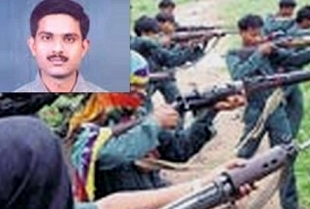
How not to deal with a hostage situation
Malkangiri District Collector Vineel Krishna’s kidnapping and the Orissa government’s reaction is a case study on how not to deal with a hostage situation.
Nine days after their kidnapping by Maoists, Malkangiri Collector Vineel Krishna and Junior Engineer Pabitra Majhi were finally released in exchange for Orissa government accepting several demands that were made by the kidnappers. Krishna and Majhi are safe but the agreement to release jailed Maoists and dropping charges may worsen the security situation in Orissa and bolster the Maoists and result in the deaths of scores of policemen and common people. Strangely though, Vineel Krishna has been turned into a hero and there is a sense of celebration and achievement surrounding what really is utter capitulation by the Orissa government to an act of cowardliness and treachery. Orissa Chief Minister Naveen Patnaik’s statements do not contain a trace of guilt or responsibility. The media do not seem to be considering it a failure, leave alone feeling the need to ask pertinent questions about the entire episode.
It is hard to fault Vineel Krisha for entering the village where he was kidnapped on a motorcycle and with no security. Taking tours to examine progress in development projects is a part of the ideal routine of a Collector. Therefore, venturing into the village was a responsibility, not a choice. He did not do it “unnecessarily.” Fault lies in the set of circumstances that kept an honest and hardworking government official like Vineel Krishna unsecured while performing his duties – abysmal infrastructure, absence of security guards and no firearms for self-defence. It was not as if Vineel Krishna could command an army of security guards to accompany him on armoured four wheel drives on four lane roads. He did not have even a pistol for self-defence. One must admire Vineel Krishna for being an exception from many other collectors who would normally spend their time appending signatures and pushing files at the Collectorate or spend the rest of their time with family at the Collector’s Residence in the district headquarters, basking in the pride and glory of being the district’s foremost citizen.
In hostage situations, propaganda plays a crucial role. In this episode, the Maoists pulled off a clever piece of propaganda – that the Maoists shifted their place every day, implying that it was impossible for any rescue mission to find them. It seems like everyone fell for it and the thought of a rescue mission was rooted out of too many minds. Even if we assume that the group walked continuously for 6 hours a day at 4 kmph, they could not have moved beyond 20-25 kilometers in a single day. Walking more than 10-15 kilometers in a single day is no mean task and is frankly unrealistic considering the thick jungle and the presence in the group of the Collector and the junior engineer, who are not as adept as the Maoists in crunching miles in the jungle on foot. If they did move such a long distance, they could not have done so without leaving trails or being noticed. At a conservative estimate, assuming two gunmen (or gunwomen, lest I’m accused of gender bias) keeping constant watch on the abductees and four gunmen keeping guard, collecting firewood, cooking food and performing other sundry tasks, and one leader, it adds up to nine people, a sizeable group.
In fact, they moved only four times in nine days. It was not impossible for a commando team to locate the group and stage a rescue mission. All this might seem too farfetched considering that staging rescue missions has never been a standard procedure in India’s responses to abductions and hijackings, and states such as Orissa lack professional, dedicated anti-Naxal commando forces such as the Greyhounds in AP for such demanding tasks. Besides, the Orissa government hardly showed the will to end the hostage situation on favourable terms. But the question remains: did the Orissa government also fall to this propaganda? Did the thought ever cross the minds of the officials that the government could go slow on the negotiations for a few days to give a window of opportunity for a rescue mission?
But how could the government control the pace of the negotiations when the negotiators that it sent were handpicked by the Maoists themselves! The negotiators are no friends of the government – they are “human rights” activists. This blunder effectively surrendered whatever little control of the situation that the government had into the hands of the kidnappers. Besides, the Orissa government seemed to have only one objective in mind – release of the two abductees at any cost, even a worsened security situation and a strengthened insurgency. No wonder the Orissa government looked hopeless and crawled before the Maoists when asked to bend. It agreed to several demands.
The entire episode is a classic case of how not to deal with a hostage situation. At a time when we could do with innovative strategies to counter the Maoists, the Orissa government got even the basics wrong. The two abductees are safe but their release comes at the expense of scores of policemen and common people who may lose their lives once the Maoist demands are met by the Orissa government. This is nothing short of an abdication of responsibility by the Orissa government towards the people.